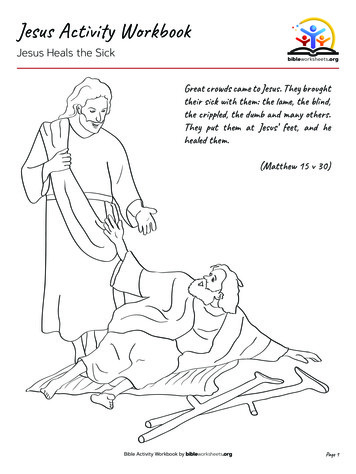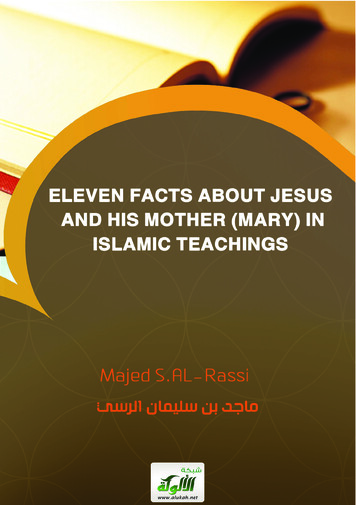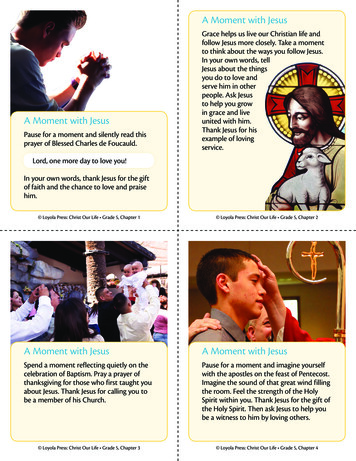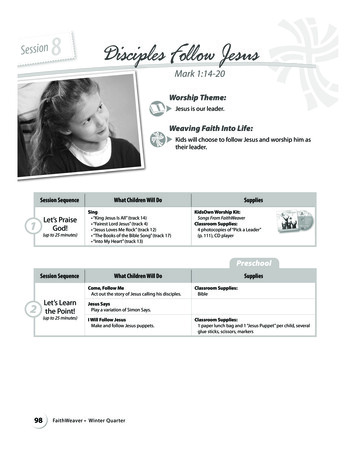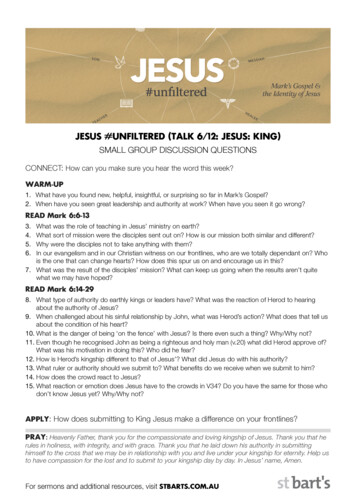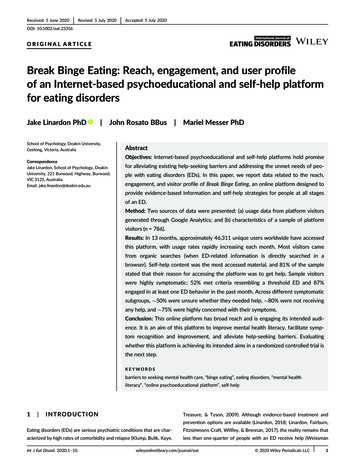
Transcription
INGESTING JESUS: EATING AND DRINKING IN THE GOSPEL OF JOHN
INGESTING JESUS:EATING AND DRINKINGIN THE GOSPEL OF JOHNByJANE SUZANNE WEBSTER, M. A.A ThesisSubmitted to the School of Graduate StudiesIn Partial Fulfilment of the RequirementsFor the DegreeDoctor of PhilosophyMcMaster University Copyright by Jane Suzanne Webster, February 2001
DOCTOR OF PHILOSOPHY (2000)McMASTER UNIVERSITY(Religious Studies)Hamilton. OntarioTITLE:Ingesting Jesus: Eating and Drinking in the Gospel of JohnAUTHOR:Jane Suzanne Webster, B. Th. (McGill University)M. A. (McMaster University)SUPERVISOR:Professor Adele ReinhartzNUMBER OF PAGES:vi,23311
ABSTRACTThe Gospel of John often uses ingesting language. First. it refers to concreteelements of food and drink (such as bread, water, fish and wine) and the actions of eatingand drinking. Second, it uses metaphors of food and drink; for example, Jesus is the"bread oflife" and the "source ofliving water." Third, it uses meals as the setting formuch of the narrative. The prevalence of ingesting language in various contexts andgenres establishes it as a primary literary motif in the Gospel of John.While the individual passages involving food, drink and ingesting have not goneunnoticed in the history of 10hannine scholarship, no major monograph has addressed themotif as a whole nor drawn specific conclusions about its function in the Gospel.Drawing on the literary theory of William Freedman, this study first extends the limits ofthe ingesting motif to include phrases drawn from the semantic domain of ingestion aswell as narrative contexts that have been excluded, for the most part, from previousstudies. By extending these limits, this study affirms more emphatically the relationshipbetween eating and drinking and the death of Jesus. In particular, ingesting languageprovides a way to describe both the role of Jesus as the one who is incarnate as "flesh"but who must die in order that others might eat and live, and the role of the believer whois "to eat and drink Jesus." This study will thus argue that the ingesting motif serves as avehicle for Johannine soteriology.This conclusion has implications for the extended debate concerning Eucharist111
traditions in the Johannine literature. for although the Eucharist is not specificallymentioned in the GospeL the prevalence of the ingesting motif suggests that eating anddrinking playa significant role in the Johannine understanding of salvation.IV
ACKNOWLEDGEMENTSThere are several people that I would like to thank for their support andencouragement while writing this dissertation. First and foremost, I wish to thankProfessor Adele Reinhartz whose important insight and advice at critical moments hasenabled this project to take shape. Thanks are also due to Dr. Stephen Westerholm andDr. Eileen Schuller for their careful reading and helpful suggestions. Megan Webster andLori Vos have offered valuable editorial comments as "interested readers."This project could not be completed were it not for those who have inspired andencouraged me over the past few years. My husband, Thomas Webster, has been sosteadfast in his support and encouragement. He learned to cook so that I could takeadvantage of my burst of inspiration between 4:00 and 6:30 p.m. (though I suspect thathunger might have something to do with it!). He facilitated a quiet and protectedenvironment, freeing me from the distractions that accompany a busy household. Heunderstood when I opted to work rather than play. He financed my growing library andmy trips to conferences. He even agreed to the installation of a hot tub under the stars!Husbands don't get much better than my Tom!My daughters, Megan and Gillian, have sustained me. Seeing how important thisadventure was for me, they respected my need for "thinking time" and my long hours infront of the computer. They adjusted to my random returns to normalcy and myspontaneous need to celebrate esoteric accomplishments. They listened patiently while Itried to argue my way out of a paper bag. They always welcomed snuggles and myquestions about their lives. They are the best part of my life.v
One of the greatest pleasures for me in the past few years has been the friendshipof my parents and siblings. Nor can colleagues and friends go unmentioned in this list ofacknowledgements. Dr. Renee Desjardins, Patricia Fletcher, my study group at McGill,and my colleagues with SAMS all deserve my thanks.Finally, the completion of this project would not be possible without the generousfunding of the Social Sciences and Humanities Research Council of Canada and theOntario Graduate Doctoral Fellowships program.Vl
Table of ContentsIntroductionChapter I: Lamb of God -2John 1:29,3637Chapter 2: The Wedding in Cana (John 2: I-II) and Consumed with Zeal (2: I 3-25)50Chapter 3: Eating and Drinking in Samaria -71John 4:4-42 (7:37-39, 12:24)Chapter 4: Tasting Life (John 6: 1-71) and Tasting Death (8:51-52)89Chapter 5: Supper in Bethany -127John 12: 1-8Chapter 6: The Last Supper-John 13:1-30 and 15:1-17140Chapter 7: First and Last Drink -175John 19:28-37 (18: II)Chapter 8: Resurrection Breakfast Conclusion: Ingesting Jesus Works CitedJohn 21 : 1-25Eating and Drinking in the Gospel of John1852052 I7
2Introduction"To eat is human, to digest, divine."- Charles Townsend Copeland. EpigramIn an article entitled, "Metaphor and Religion," David Tracy argues that "the study ofmetaphor may well provide a central clue to a better understanding of that elusive andperplexing phenomenon our culture calls religion."l All religious traditions are grounded, heobserves, on several fundamental root metaphors that define a community's vision of reality.In the Christian tradition, recent interpretation of these root metaphors has undergonemethodological revision. First, scholars better appreciate the broad range of modes of beingin-the-world presented in the multitude of New Testament metaphors. Second, they distrusttraditional interpretations that merely substitute an "accepted" theological concept, limitingthe scope of interpretive possibilities. Third, they are less sure that the historical Sitz imLeben of the early Christian community will shed light on the definitive interpretation ofmetaphors. Fourth, and finally, they have insisted on semiotic, structuralist, semantic andliterary critical analyses to develop a sense of the whole text, and within that text, the senseand meaning ofthe metaphor. Thus, Tracy argues, religious metaphors should be seen astensive, dynamic and constructive literary devices that function rhetorically. This challengeis taken up here in a study on the Gospel of John, specifically as it pertains to the cluster ofmetaphors related to the language of eating and drinking - or what will be called "ingestingIIn Critical Inquiry, (Autumn 1978): 91-106, citation p. 106, Tracy's italics.
3language."Ingesting language is found throughout the Gospel of John and can be divided intotwo main categories. The first category includes specific references pertaining to food anddrink and to the acts of eating, drinking and feeding. It embraces both simple references tofood and drink, such as bread, water, fish and wine, as well as metaphorical language drawnfrom the semantic field of food, drink and ingesting. For example, Jesus refers to himself asthe bread oflife (6:35,51) and as the source of living water (4:10-15). The one who believes"drinks" of Jesus and will provide "a river ofliving water" (7:37-38). Jesus refers to hisupcoming death as "drinking the cup that his Father has given him" (18: 11). In the last scenein the Gospel, Jesus tells Peter, "Feed my sheep" (21: 15-17).The second category consists of passages describing gatherings in which eating anddrinking ostensibly occur, collectively referred to here as "meals." The first meal is awedding banquet at Cana in 2: 1-11 where, prompted by his mother, Jesus turns six jars ofwater into fine wine. The second is set in Sychar, where Jesus asks for a drink of water froma Samaritan woman and the disciples bring him food (4:4-42). The third meal takes place ona mountain where Jesus turns five barley loaves and two fish into enough food to satisfy fivethousand people (6:1-14). At the fourth meal, Mary, Martha and Lazarus give a supper forJesus in Bethany. Mary anoints Jesus' feet with ointment and then wipes them with her hair(12: 1-8). During the fifth meal, set in Jerusalem the night of his arrest, Jesus washes thedisciples' feet and then sends Judas off to betray him (13:1-14:31). The sixth and final mealtakes place after Jesus' resurrection, on the shore of the Sea of Galilee. Jesus prepares abreakfast of fish and bread over a charcoal fire and serves it to the disciples (21 : 1-14).Curiously, not all of these meals feature eating and drinking - some only allude to it -but
4the repeated lise of a meal setting is noteworthy.The prevalence of eating and drinking language, references to food and drink and thenarrative context of meals establishes ingestion as a significant literary motif in the Gospel ofJohn. It takes its place among other motifs such as light and dark, above and below, and thegood shepherd. While this ingesting language has not gone unnoticed in the history ofjohannine scholarship, no study to date has traced the motif through the Gospel, related thevarious passages to each other, or drawn specific conclusions about the function of the motifin the Gospel as a whole. Without such a study, however, it is impossible to determine howthis motif fits into the Gospel's structure and purpose. Limited studies have examined thevarious metaphors and symbols in isolation, or as Tracy has pointed out. with a theologicalagenda that restricts the scope of the metaphorical meaning -usually to sacramental ism? Inother words, they have not extended the limits of the motif to include the narrative context ofmeals and language drawn from the semantic domain of ingesting, nor have they attempted tounderstand the role of the motif in the gospel narrative. This dissertation is the first attemptto do so.While not the central focus ofthis study by any means, any survey of ingestinglanguage in the Gospel of john has implications for the debate about the place of theEucharist in the johannine community. Scholars on one side of the debate assume that thefourth evangelist must have known the traditions of the Eucharist; thus, passages that featurebread and wine are thought to be eucharistic. Scholars on the other side of the debate arguethat the evangelist either did not know these traditions or did not approve of them. Thisquestion will be addressed briefly in the concluding remarks.2A survey on the state of this question follows on page 21.
5The aim of this study is to define the literary motif of ingesting language and itscomponent parts. It will note the use of this language in recurring contexts, demonstrate itsrole in the Gospel and offer some reflections on its rhetorical function. It will be argued thatthe ingesting motif is a vehicle for Johannine soteriology. Specifically, ingesting languageprovides a way to describe both the role of the believer ("to eat and drink Jesus") and the roleof Jesus as the one who is incarnate as "flesh" but who must die in order that others might eatand live. In this way, the ingesting motif speaks of soteriology in a microcosmic way,reflecting the Gospel's soteriology as a whole. At the same time, the complex metaphoricallanguage challenges readers to struggle for meaning -to chew it over, and if palatable. toswallow.It will prove useful at this point to outline the soteriology of the Gospel of John, andthen to sketch out the way in which ingesting language reflects this larger soteriologicalconstruct.Soteriology in the Gospel of John and Ingesting LanguageThe Gospel of John as a whole describes the way that believers gain eternal life, orare "saved." People in the world are understood to be in bondage to their sin, which will leadto their eternal death (8:34-36). God, motivated by love, initiates a rescue plan by sendinghis son, Jesus, into the world (3: 16-17). Jesus dwells among his people (6:50) as the "word"(I: 1-18); he teaches (5:34) and does signs (20:30). Those who believe in Jesus and keep hisword (3: 15-21,36; 5:24; 8:51-52) will not die in their sin (I :29; 8:21,24,34-36), but willbecome children of God (I: 12) and have eternal life (3: 16; 6:47; 11:25-26).An essential element in this scheme of salvation is the human response: to believe in
6Jesus. When Jesus is asked by the crowd, "What must we do to perform the works of God?"Jesus responds by saying, "This is the work of God, that you believe in him whom he hassent" (6:28-29). Believing in Jesus is conceived in a variety of ways in the Gospel. Forexample, believing is "coming into the light" (12:36,46) or "receiving" Jesus (I: 12). Animportant metaphor for "believing" is that of "ingesting" Jesus. In John 6:40, it says that "onthe last day," Jesus will raise "all who see the Son and believe in him." In John 6:54, it saysthat "on the last day," Jesus will raise all "who eat the flesh ('tT]V crciPKU) of the Son of Manand drink his blood." Both those who see and believe and those who eat the flesh of the Sonof Man will have eternal life. This phrase "to eat the flesh" recalls the prologue -"In thebeginning was the Word, and the Word was with God and the Word was God .,. And theWord became flesh(crcip )and lived among us" (I: 1,14). Though generally understood tomean that Jesus took on human form (became incarnate) and was able to participate in humanexperience,3 "the Word became flesh" also hints that Jesus becomes "flesh" or "meat" that isto be eaten. 4 In John 6:53, Jesus emphatically states, "Very truly, I tell you, unless you eatthe flesh ('tT]V crciPKU) of the Son of Man and drink his blood, you have no life in you." Jesusis also the "bread which has come down from heaven" (6:4 J, 50-5 J); again, this bread refersto his flesh (t]crc:X. ,6:51). Furthermore, Jesus provides "living water" (4: J0, 14; 7:37;19:34). He says, "Whoever comes to me will never be hungry, whoever believes in me willnever thirst" (6:35). The one who believes will "never taste death" (8:52). Therefore, just as3 See, for example, R. Brown, The Gospel ofJohn (i-ixJ. Introduction. Translation and Notes (2 vols.; AB 29;Garden City, New York: Doubleday, 1966), I: 13,30-32; C. K. Barrett. The Gospel According to St .John (2 ndedition; Philadelphia: Westminster, 1978),98; R. Schnackenburg The Gospel According to 5;t .John (3 vols.;trans. K. Smith; New York: Seabury, 1980),1:265-68.4 For the range of meanings for this word, see Walter Bauer. "crap!;" in.-l Greek-English Lexicon of the Nell'Testament (2d ed.; trans. and adapt. of the 4th ed. by W. Arndt, F. W. Gingrich; rev. and aug. by F. W. Gingrich,1hF. W. Danker from Bauer's 5 ed, 1958; Chicago: University of Chicago Press, 1979),743.
7believing in Jeslls leads to salvation. so also ingesting Jeslls leads to salvation. The Gospeltherefore uses ingesting language as one way to describe what it means to believe in Jeslls.In order for this "food"' to become available for eating. however, Jeslls mllst first die.Again. images of food are used to describe this concept. In referring to his approachingdeath,5 Jesus says, "Unless a grain of wheat falls into the earth and dies, it remains just asingle grain; but if it dies it bears much fruit" (12:24). This "fruit," or the harvest of grain, isused to make bread, recalling 6:51: "1 am the living bread that came down from heaven.Whoever eats of this bread will live forever; and the bread that I give for the life of this worldis my flesh." Thus, in order to feed believers the bread of his flesh, Jesus, as a grain ofwheat, must first "fall into the earth and die." In addition to this passage, the Gospel presentsJesus as the "Lamb of God" (I :29, 35) who dies at the hour that the lambs are to be sacrificedfor Passover (Exod 12:6; John 19: 14).6 This festival, which celebrates a time when theHebrews are saved from death by smearing lamb's blood on their doorposts and lintels (Exod12: 1-20), includes the slaughter of a lamb and the sharing of its meat. Thus, Jesus isslaughtered and his "flesh" is the substance that is shared with believers; they too are savedfrom death (6:51-53).7 Therefore, Jesus' death is necessary for believers to have eternal life.Narratives that refer to people gathering to eat and drink emphasise the necessity ofJesus' death. First, meal narratives provide the setting for discussions about the meaning andpurpose of Jesus' death. During a meal in Bethany, Mary anoints Jesus' feet with oil bought"for the day of [his] burial" (12: 1-8). During another meal on the night before his death,, Brown, Gospel, 1:471-73.See also 19:29 (cf. Exod 12:22) and 19:36 (cf. Exod 12: 46; Num 9: 12). For a discussion of the day and hour ofJesus' death as the day and hour of the Passover sacrifice in the Gospel of John, see Brown, Gospel. 1:882-83,895-96; W. A. Meeks. The Prophet-King Muses Traditions and the Johannine Christology (Leiden: E. Brill,1967), 77; Barrett, Gospel. 5 I.7 Note that the "bread oflife" discourse is set in the narrative context of Passover (6:4).6
8Jesus knows "that his hour had come to depart this world and go to the Father"' and he washesthe disciples' feet (13: I-II). Second, a number of meal narratives depict Jesus as guest, hostand food. At the start of these narratives, Jesus is characterised as a guest, but he quicklybecomes a host who offers food and drink. He is the provider of physical food and drink and,as such, one who sustains temporal life. As the narrative proceeds, he is revealed, not just asthe provider of the food and drink, but as the very substance of the food and drink. That is, itis his flesh, available through death, which gives eternal life. For example, after Jesusmiraculously feeds bread and fish to a great multitude, he discusses the need for his deathwhen people come back to him for more "bread from heaven" (6: I-59, especially vs. 30-31,51). Third, the various meal narratives present the range and the expected response to Jesus'death. Some people are willing to receive what Jesus provides but are unwilling to "eatJesus' flesh" (6:52-59). Others accept Jesus both as the provider and as the substance of foodand drink. To these, Jesus gives the task of feeding others (see, for example, 21: 1-19). Thus.in the meal narratives. the Gospel underscores both the importance of Jesus' death and theexpected response of believers.The ingesting motif, therefore, is a vehicle for Johannine soteriology. It provides away to describe the role of Jesus as the "Word made flesh" who must die in order that othersmay eat and live. It also provides a way to describe the role of the believer as ingesting Jesusand feeding others.A Note about Methodology: DefinitionsThe theoretical approach that is used in this study is situated within the largerframework of literary and, more specifically, narrative criticism. Narrative criticism does not
9seek to answer questions of history, sociology, form. or sources. It does not seek to definethe shape of the community that produced the text, or the historical events that sparked thetradition. Narrative criticism brackets these questions and, instead, focuses on the story thatis being communicated and the way in which that story is told.8Within this story, characters act through a plot, respond to and negotiate climax andcrisis, develop relationships, and express emotions. They are situated in and proceed throughnarrative time and space. They speak to each other and interact with each other. Narrators,who ostensibly tell the story, inform the reader -often through direct speech or asides 9what the characters think, why they act as they do, and when they misunderstand. Theyprovide explanations and justification; they direct attention. Behind the narrator, however, isthe implied author who makes choices such as what to tell, in what order to tell it, what toemphasise, what to ignore, what knowledge to presume, and what proof is valid. Thenarrative elements might thus be divided in two: the "what" of the narrative includes suchaspects as characters, plot, and setting; the "how" of the narrative includes such aspects as thepoint of view, pace, repetition, gaps, parallels, type scenes, focalisation, irony, and (ofespecial interest to this study) figurative language. 1O Figurative language includes metaphors.signs, similes, symbols, and motifs.Of course, knowledge of the history and culture of the first century is a crucial aid to understanding John'sstory-world, but that is a different matter from using elements of the text to reconstruct historical events. See D.Rhoads, "Narrative Criticism and the Gospel of Mark," JAAR 50 (1982): 413. S. Motyer ("Method in FourthGospel Studies: A Way out of the Impasse?" JSNT66 [1997]: 27-44) argues that narrative criticism must takehistorical criticism seriously because the narrative presupposes historical reality lying behind the text. See alsoD. Tovey, Art and Act in the Fourth Gospel (JSNTSup 151; Sheffield: Sheffield Academic Press, 1997). Thehistorical basis of the narrative, however important, will not be the main focus of this study.o For a description of the roles of implied author and narrator, see R. Alan Culpepper, Anatomy of the FourthGospel: A Study in Litermy Design (Philadelphia: Fortress, 1983), I-50.10 "What is communicated is stOlT, the formal content element of narrative; and it is communicated by discourse,the formal expression element" (S. Chatman, StOlY and Discourse Narratil'e ,Structure in Fiction and Film[Ithaca: Cornell University Press, 1978],31).8
10Metaphors and similes are means of comparison. A simile compares one thing withanother using the words "like" or "as." "Superman is as fast as a speeding locomotive."There is no equation in a simile. Superman is not a locomotive, but he is able to move veryfast, so in this way, he resembles a locomotive. To say that Superman was as fast as aspeeding bullet would not contradict the premise in the first sentence. Superman is as fast asboth a bullet and a locomotive.A metaphor, on the other hand, does imply an equation. "Like" or "as" is not used,but the copula, "is," often joins a metaphor and its referent. The word "metaphor" itselfmeans "carrying out a change." Metaphors speak about one thing or state of affairs in termsthat are suggestive of another. I I We wi II take as an example the sentence, "The room is anoven." Here, room and oven are equated, or the room "has changed into an oven:· 12 Buthow can that be? If we assume that a room is a place where people can be or live, it is absurdto imagine that someone would be or live in a small compartment used to bake bread. Aroom and an oven are not the same thing. 13 Yet, if we imagine the characteristics of an oven-say, that it is small, dark and very hot -we can picture the room as also small, dark andvery hot. The characteristics of the oven are applied to the room and we have a clear imagenot only of the appearance of the room (small and dark), but of the feel (very hot) andperhaps even the emotional atmosphere of the room (claustrophobic). In this way, the ovenserves as a vehicle to carry the meaning of the referent, or what I. A. Richards calls its tenorJ. Soskice, Metaphor and Religious Language (Oxford: Clarendon, 1985),53.E. Roberts, Writing Themes about Literature (6 1h ed., Englewood Cliffs, New Jersey: Prentice Hall. 1988),121-22. J. Culler, "Commentary," Nell' LiteI'm), HistOl:v 6 (1974): 219-29, distinguishes two ways of thinkingabout metaphor. In the philosophical way of thinking, metaphors function, as does all language. to fill the gapbetween sense and reference. There is usually a one-to-one correspondence between sense and reference. In therhetorical way of thinking, metaphors are perceived as a problem of incongruity in the text that causes the readerto strive for intelligibility.lJ Roberts, /l'f"Itil1g. 121.II12
11(i.e . the room).14 The detining characteristics of a metaphor therefore include an equationbetween one thing and another that "may not normally be expected in a given work. butwhich may be unusual, unpredictable, and even surprising."15 To speak metaphorically. then.is to speak of one thing in terms appropriate to another. '6The juxtaposition of two disparate images, such as a room and an oven, results in atension that seeks resolution. '7 Because metaphors are based on Iikeness in difference and "asystem of commonplace associations," I & the reader is required to make an educated guess asto which characteristics of the vehicle are to be transferred to the tenor.19Because differentreaders will guess differently, the meaning of the metaphor has infinite possibilities. 20 In ourexample above, another interpreter might suggest that it is passion that drives up theemotional temperature in the room. Ricoeur argues that the larger context provides clues tothe meaning ofa metaphor; a good explanation of the metaphor will then account for all (ormost) of the clues?1 The metaphor will, in turn, contribute to the meaning ofthe work as awhole, resulting in a hermeneutical circle in which the meaning of both the individualmetaphor and the work are enriched.22 Finally, a metaphor tells us something new aboutThe Philosophy of Rhetoric (Oxford: Oxford University Press, 1936),96.Roberts, Writing, 122.16 C. Koester, Symbolism in the Fourth Gospel: Meaning. MystelY. Community (Minneapolis: Fortress, 1995).6.17 P. Ricoeur, Interpretation Theory: Discourse and the Sl/Iplus q{ Meaning (Fort Worth: Texas ChristianUniversity Press, 1976),50-51. Culler (,'Commentary," 229) emphasises the importance of tension establishedin metaphors and states that it is the "resistance to replacement operations" that gives literature its power.18 P. Ricoeur, "Metaphor and the Main Problem of Hermeneutics," New Literary History 6 (1974): 104.Richards (Philosophy, 55) argues that the sense of the author's words "are resultants which we arrive at onlythrough the interplay of the interpretive possibilities of the whole utterance," or what he calls the complete"interanimation" of words.10 N. Friedman, Form and Meamng in Fiction (Athens: University of Georgia Press, 1975), 289-92.20 Ricoeur, "Metaphor," 107.21 Ibid . 104.22 Ibid., 106. 109-110. D. Wead (Litcraty Del'ices in .John·s Gospel [Basel: Freidrich Reinhardt Kommisverlag.1970]. 73) notes that metaphors and double meanings are distinct. In metaphors. the various aspects of meaningsmerge creating something new. In double meanings. two aspects of meaning are held separately and do notcreate something new.1415
12reality because it creates new meaning;23 this is especially true when a metaphor is shockingin its equation of one thing with another?4 Margaret Atwood's book title The EdibleWoman,25 which brings two disparate notions together, provokes such creative reimagining?6Among the categories of figurative language, signs are distinct from metaphors andsimiles. As a literary device, a sign signals an event that is about to happen in the narrative?7For example, thunder indicates that a storm is approaching, or the presence of the owlanticipates an imminent death. The meaning of a sign is determined arbitrarily, sometimesby allusion to the signs of nature, but more often by the text itself.28 This literary definition isnot to be confused with the lohannine use of the term "sign"( JTU.U: tOv),which is a technicalterm referring to an action of Jesus that points to his identity (20:31). To avoid confusion,the term "sign" will only be used in this study in the 10hannine sense.The distinction between metaphor and symbol is more difficult.29 Wellek argues thatif an image appears once, it is a metaphor. If it recurs persistently, both as presentation andrepresentation, it becomes a symbol, or a part of a symbolic (or mythic) system. 30 However,Ricoeur, interpretation, 52-53; Roberts, Writing, 122.R. Kysar ("Johannine Metaphor - Meaning and Function: A Literary Case Study of John 10: 1-8," Semeia 53[1991]: 98-99) says that the resulting "irresolvable paradox" shocks the reader into a new kind of experience.2S Toronto: McClelland & Stewart, 1969.26 D. Davidson ("What Metaphors Mean," Critical Inquiry [Autumn 1978J: 31-47) argues that metaphors evokeassociations that are limitless; that is what keeps them alive. Thus, metaphors cannot be dependent on theirhistorical context or they would not be metaphors. See J. Derrida, "White Mythology: Metaphor in the Text ofPhilosophy," New Literary History 6 (1974): 12; Ricoeur, "Metaphor," 100. On the other hand, if a metaphor isover-used or has a one-to-one correspondence, it is a dead metaphor. because it no longer has the power to evokenew meanings. For example, the "leg ofa table" is a dead metaphor. See R. Wellek and A. Warren, Theory ofLiterature (3'd ed., New York: Harcourt Brace & World, 1956), 196.27 P. Wheelwright, The Burning Fountain: A Study in the Language of Symbolism (Bloomington: IndianaUniversity Press, 1954), 20.28 J. Painter, "Johannine Symbols: A Case Study in Epistemology," Journal of Theology ofSouth Africa 27(1979):33.29 On the difference between metaphor and symbol, see Ricoeur, interpretation, 45-69, especially 63-69.30 Wellek, Theory, 189.2324
13metaphors and symbols are distinct because of the nature of their tenor. Metaphors have botha vehicle and a tenor or referent; it is the role of the reader to understand the relationshipbetween them. With symbols, however, the tenor is implied; only the vehicle is supplied inthe form of an object, an action, a pattern or a person, each of which stands for something inits own right. It is the task of the reader to discover which tenor is meant. The tenor may beidentified by either external or internal relationships. External relationships are establishedthro
Chapter 5: Supper in Bethany - John 12: 1-8 127 Chapter 6: The Last Supper-John 13:1-30 and 15:1-17 140 Chapter 7: First and Last Drink - John 19:28-37 (18: II) 175 Chapter 8: Resurrection Breakfast - John 21 : 1-25 185 Conclusion: Ingesting Jesus - Eating and Drinking in the Gospel of John 205 Works Cited 2 I 7
